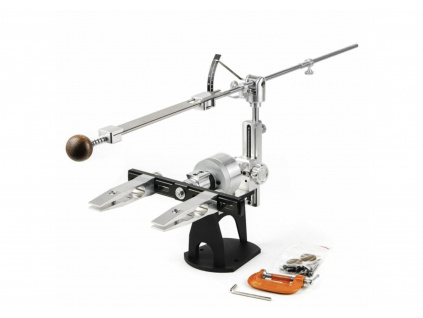Convex adapeter TSPROF K03
Code: TS-PT2000260Related products
Product detailed description
The universal attachment for convex sharpening of knives is an adapter that is mounted on the abrasive holder and provides an even change in angles across the entire width of the secondary bevels. As a result of the work, the radius shape of the lens is obtained.
Lenticular or convex sharpening, shows itself very well under shock loads, during the cutting of reeds, coastal shrubs and grass, large raw bones, dead branches. It is also more effective for deep cutting compared to knives with V-shaped grind, provided that the blade thickness is similar - this is due to less 'sticking' to the material. This form is most suitable for long-bladed combat weapons, large knives, and logging axes.
Angle ranges are determined by the position of the rod in the attachment. The attachment is marked with the appropriate angle ranges. During the movement of the abrasive along the secondary bevel from the cutting edge line to the knife spine, the range of angles changes in the direction of reducing the angle. It is necessary to choose a range of sharpening angles depending on the reduction of the blade. With a minimum thickness of 0.2-0.4 mm, the adapter of 4.3 degrees is suitable; with an average thickness of 0.4 – 0.6 mm, the adapter of 7.2 degrees; with a thick reduction of 0.7 mm, the adapter of 10.7 degrees.
Included:
Adapter for three angle ranges: 4.3°, 7.2°, 10.7°
Installation kit with 4 mm screw
TSPROF je rúská firma, ktorá vyrába jedny z najlepších brúsnych systémov na nože a dláta na svete. Prvé dizajnérske práce na základných prvkoch brúsky Profile sa začali už v roku 2010. Dovtedy zavedené metódy ručného brúsenia sa uskutočňovali hlavne pomocou primitívnych plastových „záloh“ vyrobených vo forme mnohých čínskych klonov.

